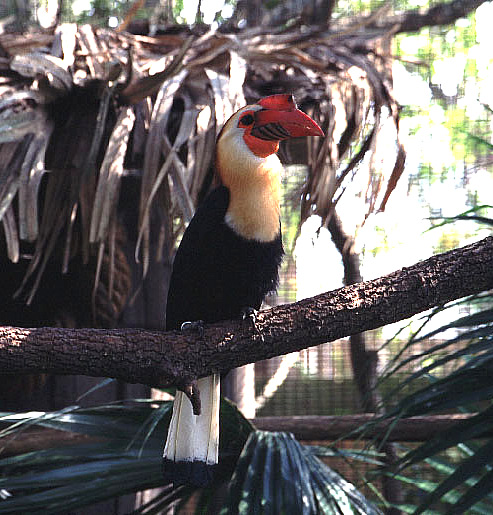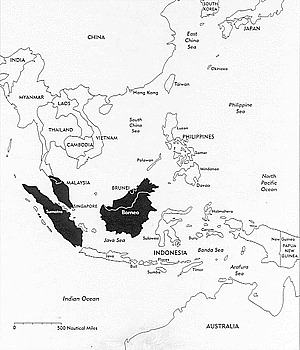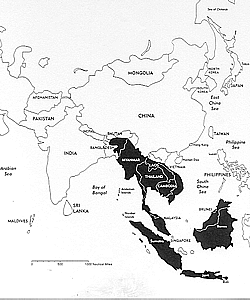Knobbed Hornbill (Aceros cassidix)
GENERAL INFORMATION
The Hornbill Taxonomic Advisory Group (TAG) has adopted taxonomy used by Kemp (1995). The older genus name Rhyticeros might be seen in the literature (Kemp 1979). Other common names in use include: Red-knobbed hornbill, Island hornbill, Buton hornbill and Celebes hornbill.
Description
Adult male: crown and back of head rufous-brown; face and neck pale rufous to cream colored; body and wings black; tail white; bill yellow with orange-brown ridges across base of both mandibles; high red casque; bare circumorbital skin pale blue, with dark blue eyelids; bare throat skin dark blue with black band through lower edge and turquoise skin below band; eyes orange to red; legs and feet black.
Adult female: similar to male but smaller, with less developed yellow casque; head and neck all black; throat skin with smaller black band; eyes brown to orange.
Immature: plumage like adult male for both sexes, but casque undeveloped; bill pale yellow, with red wash at base; facial skin paler version of adult male; eyes dark brown with yellow rim. At 10-13 months, the casque starts to develop and the juvenile female begins to molt into adult head and neck colors. (Kemp 1995 and pers. obs.)
Range, habitat, and status
A. c. cassidix is restricted to the Indonesian islands of Sulawesi, Lembeh, Togian, Muna, and Butung where it occurs in evergreen forests up to 1800m. In South Sulawesi, this species has been declared the state bird (Poonswad 1993). Kinnaird and O'Brien (1996) have documented high densities around fruiting trees but caution that the species may be declining as forest habitat is also declining. It is difficult to accurately census a nomadic species that congregates around fruiting trees; counts based on temporary, mobile aggregations may result in an exaggerated estimate of the population's true numbers. A second subspecies, A. c. brevirostris occurs on the islands of Butung and Muna. Kemp (1995) suggests that this form represents the southern end of a cline through Sulawesi.
Captive propagation
The first
documented captive breeding in this region occurred at Audubon Park and
Zoological Garden in 1991. Michi (1993) wrote about breeding this species
at Walsrode Vogelpark at Mallorca, Spain.
Recent successful breedings occuring in this region are from pairs at
the San Diego Wild Animal Park, San Diego Zoo, and Los Angeles Zoo. This
studbook includes 70 historical records. Currently, there are 11.9 living
birds in 8 institutions recorded in this studbook.
Reproduction
at AUDUBON represents the first time a F1 bird has bred. The sire hatched
at SEATTLE in 1996. Although the chick did not survive, this is encouraging
for developing a self-sustaining captive population.
Similarly, good news comes from SEATTLE where two young birds have shown
interest. The female (hatched in 1997) has been almost daily, spending
short periods of time inside the nest cavity.
Wrinkled Hornbill (Aceros corrugatus)
GENERAL INFORMATION
The other common name in use is Wrinkled Hornbill.
Description
Adult male: crown, back of neck, body, and wings black; face and front of neck white; tail white with broad black base; bill with high wrinkled casque ridge above basal half, yellow, with red-brown base and ridges across lower mandible and with casque deep red; bare circumorbital skin blue; inflatable bare throat skin pale yellow; eyes red; legs and feet black.
Adult female: smaller than male, with casque a low ridge; face and foreneck black; bill paler yellow; circumorbital and throat skin blue; eyes gray-brown; legs and feet greenish gray.
Immature: plumage like adult male for both sexes, but casque undeveloped and bill ridged; bill pale yellow with of orange at base; facial skin pale yellow; eyes yellow with brown tinge; legs and feet blue-gray. Immature female molts into adult face and neck colors at approximately one year.
Kemp (1995) mentions that birds from Sumatra and Malay Peninsula are larger and lists them as A.c. rugosus.
This species
occurs in southern Thailand, Peninsular Malaysia,
the Indonesian islands of Sumatra, Rupat, Payong, Batu, and throughout
Borneo. I was recently recorded in southwestern Cambodia. It inhabits
lowland primary evergreen forest. Generally uncommon, but fairly common
in North Sarawak, Brunei, and south Sumatra; rare in Peninsular Malaysia;
endangered in Thailand. As with other hornbills, they are nomadic, coveringlarge
areas between foraging areas and roosts. This makes surveys difficult.
Collar et. al. (1994) lists this species as "near-threatened".
Captive propagation
This species was first bred in captivity at Audubon Park in 1988 (Sigler and Myers 1992). Presently, there are successful breeding pairs at Honolulu Zoo, San Diego Wild Animal Park, San Diego Zoo, and Ft. Worth Zoo (Lindholm 1999).
In Europe, there are several pairs that have bred recently. They are located at: Walsrode at Mallorca, Chester Zoo, Birdpark Avifauna (The Netherlands), La Palmyre (France), Palmitos Park, and Paultons Park (Low 1999; Summers 1998; Wilkinson et al 1996). Jens Lilleor at the Aalborg Zoo in Denmark is the European studbook keeper for this species (3rd edition: August 2002).
Aceros corrugatus has the greatest number of living species listed in this studbook (23.26 in 21 institutions;). There are 158 historical records. To maintain genetic variation in a self-sustaining captive population, this species will be closely managed as a Population Management Plan (PMP). With the help of Colleen Lynch at the Population Management Center, the first PMP was distributed to participating institutions in October 2003. Of the total population, only 16.20.3 are included in the PMP. Priority will be to breed wild caught birds that have no living descendants and to keep a close look at pairs that have several living descendants.
Writhed Hornbill (Aceros leucocephalus)

GENERAL INFORMATION
Other common names in use include: Writhe-billed hornbill, White-headed hornbill, Wrinkled hornbill.
Description
Adult male: crown and back of neck dark brown; body and wings black, upperparts with metallic green sheen; face, front of neck, and upper breast white, later stained cream-colored with preen oils; tail white with black tip; bill, with high wrinkled red casque ridge above basal half, and blue and black grooves between ridges across base of lower mandible; bare circumorbital skin and inflatable bare throat skin bright deep orange; yellow eyelids forming ring around red eye; legs and feet dull black.
Adult female: similar to male, but smaller, with casque a high straight ridge; head and neck all black; bill slightly paler; ridges across base of lower mandible brown.
Immature: plumage like adult male for both sexes but with brown wash around the eyes and casque undeveloped; bill colored slightly paler than adult female and without clear ridges or colors at base; facial skin bright yellow, but paler than adult; eyes blue-gray; legs and feet gray. (Kemp 1995).
Range, habitat, and status
This species is found on Mindanao and surrounding islands in the Philippines where it inhabits evergreen dipterocarp forest below 1000 meters. Its requirement for primary forest, along with its wide-ranging habits and low overall density render it vulnerable. Collar, et al (1994) lists this species as endangered due to hunting and loss of habitat. Kemp (1995) implies that it is declining over most of its range, due to loss of preferred habitat. Kemp later lists this species as near threatened (in del Hoya et al 2001).
Captive propagation.
The first known captive breeding of this species occurred in 1989 at Miami Metrozoo (Jung 1991). Myers (in press) wrote about the successful breeding at Audubon Park and Zoological Garden. This pair had hatched nine and fledged eight birds. Unfortunately, the breeding female died 11 May 1998. All the surviving offspring (2.2 presently) are in European collections (Parque El Retiro in Malaga, Spain and Chester Zoo in the United Kingdom).
San Diego Zoo had a pair of birds, the female having been captive hatched at Miami Metro Zoo in 1989. She first reproduced when she was four years old. In 1999, one chick was hand reared from this pair. There are 28 historical records. Presently there is only a single female in this region. METROZOO maintains ownership of 3 females that reside in Europe.
Roger Wilkinson
has begun collecting information for an international studbook for this
species (pers. comm.)
(Aceros leucocephalus) Gallery
Papuan Hornbill (Rhyticeros plicatus)
GENERAL INFORMATION
The common name in use is, Blyth's hornbill. Kemp (1995) notes that the Plain-pouched wreathed hornbill, Aceros subruficollis was once considered conspecific with plicatus. . There is uncertainty about the species identification of a few of the older records. Five specimens were recorded as R. plicatus subruficollis. Kemp does not recognize this subspecies. It is unclear whether they were A. plicatus or A. subruficollis. These birds (studbook #1-5) did not reproduce, and have all died. Kemp lists this bird in the genus, Rhyticeros (in del Hoyaet al 2001).
Description
Adult male: head and neck rufous; body and wings black; tail white; bill, with casque a series of low wreaths across base, pale yellow, with dark red-brown base and casque; bare circumorbital skin pale blue with flesh colored eyelids forming ring around eye; bare throat skin white with blue tinge; eyes red to red-brown; legs and feet black.
Adult female: similar to male but smaller; head and neck black; eyes brown.
Immature: plumage is similar of adult male for both sexes but casque undeveloped; bill, pale yellow; facial skin pale blue; eyes gray-brown.
Range, habitat, and status
Kemp (1995) described 6 subspecies but suggested that they might be one species representing a cline. This species ranges in eastern Indonesia, Papuan New Guinea, and Solomon Islands in primary and secondary forests below 1500 meters. This species is hunted for food and trophies. They are reported to be common in the western part of the range and more vulnerable in the eastern region. Kinnaird and O'Brien (pers. comm.) have recently completed a survey at seven sites on the island of Seram in the North Molluccas. Their preliminary estimates reveal a high hornbill density of 30 birds/sq. km. They note that abundance is most strongly correlated with the density of nesting trees and the density of adult strangler figs. Kemp records that 250 birds were counted along a 20 km. river in Irian Jaya (in del Hoya et al 2001).
Captive propagation
Euing (1995) wrote about the breeding of Rhyticeros plicatus jungei at the San Diego Zoo. As these birds were collected in Papua New Guinea, they are identified to subspecies (pers. comm: D. Rimlinger). The other A. plicatus in captivity cannot be accurately listed to subspecies. Macek (1998) wrote a short note about the most recent breeding success at Saint Louis Zoo. In 1999, a female hatched from the pair at San Diego Zoo and a male hatched at the San Diego Wild Animal Park. Unfortunately the male breeder died at the Wild Animal Park in 1999. In 2003, a female hatched at the Wildlife Conservation Society from two F1 birds. There are 52 historical records. Presently, there are 7.6.2 living birds in 7 institutions listed in this studbook.
In 1999,
Irena Pavlin from Ljubljana Zoo, Slovenia, published the first edition
of the European regional studbook for this species.
Wreathed Hornbill (Rhyticeros undulatus)
GENERAL INFORMATION
Other common names in use include: Bar-throated wreathed hornbill, Wreathed hornbill, and Northern waved hornbill.
Kemp (1995) summarized the confusion in taxonomy of Rhyticeros subruficollis (Plain-pouched wreathed hornbill) which closely resembles the sympatric R. undulatus. From 1953 to about 1969, R. subruficollis was united with R. undulatus. This could have resulted in some misidentification of these two species in older records. Kemp (in del Hoya et al 2001) lists this bird in the genus, Rhyticeros.
Description
Adult male: crown and nape rufous, face and foreneck white to cream-colored; body and wings black; tail white; bill, with casque a series of low wreaths (9-11) across base and obvious ridges across base of mandibles, pale yellow with dark orange brown base and ridges; bare circumorbital skin red with pink eyelids; inflated bare throat skin yellow with interrupted blue-black band across center; eyes dark red with narrow yellow inner rim; legs and feet dark olive-gray.
Adult female: similar to male but smaller; head and neck black; circumorbital skin flesh colored; throat skin blue with interrupted blue-black band across center; eyes dark brown with narrow blue inner rim..
Immature: plumage like adult male for both sexes but casque undeveloped; bill white to pale yellow; facial skin like adult male with lighter bands down sides of throat; eyes pale blue. Immature female begins molting to adult plumage within 7-8 months after fledging (Kemp 1995).
Due to similarity in appearance to Rhyticeros subruficollis, there is some confusion about the range of these two species. In the western part of the two ranges, there is overlap in eastern India southeast through Bhutan, Myanmar, Thailand, and possibly Peninsular Malaysia, and Sumatra. The range of A. undulatus continues east to Java, Bali, and Borneo. This species prefers primary evergreen forest up to 1675m. It is widespread but generally uncommon and as with the other birds in this genus, nomadism makes assessment of density difficult. Kemp (1995) suggests that the results of population studies obtained by surveying only communal day and night roosts may lead to exaggerated abundance figures.
Captive propagation
The first recorded successful hatching of this species was at the New
York Zoological Park in 1977 (Bell and Bruning 1978). Presently there
are two successful breeding pairs in this region: Central Florida Zoological
Park and Oklahoma Zoo.
To maintain genetic variation in a self-sustaining captive population, this species will be closely managed as a Population Management Plan (PMP). With the help of Colleen Lynch at the Population Management Center, the first PMP will be distributed to participating institutions in 2004.
This studbook covers 108 historical records, of which, 13.16 living birds in 14 institutions. Of these only 7.10 can be included in a possible PMP.
In 1999, Irena Pavlin of Ljublana Zoo, Slovenia published the first edition regional European studbook for this species.
GENERAL INFORMATION
Other common names in use include: White-crested hornbill, Long-crested hornbill.
Kemp (1995) placed this species in the genus Aceros (subgenus Berenicornis) but acknowledged that this species might be placed in the monotypic genus, Berenicornis. Kemp wrote the section on Bucerotidae in Del Hoya et al. (2001) and placed this species back in Berenicornis.
Description
Adult male: head, neck, breast, tail, and broad tips of wings white; back, wings, thighs, abdomen, and undertail coverts black; white crown feathers raised in a forward pointing crest; bill and low casque ridge black with greenish-yellow base; bare circumorbital and throat skin light blue; eyes pale yellow; legs and feet black.
Adult female: similar to male but smaller; only crest and tail white.
Immature: head, neck, and underparts black, with white feathers tips giving a mottled appearance; tail feathers black with broad white tips; bill yellow; bare facial skin grey; eyes greenish-yellow; legs and feet grey.
Range, habitat, and status
This species occurs in southern Myanmar and Thailand, Peninsular Malaysia, Sumatra, Borneo, and southwest Cambodia. It prefers primary lowland evergreen forest up to 900 meters (rarely up to 1680 meters).
It is uncommon to rare in most of this range. Since it prefers dense undergrowth and is often found close to the ground, it is generally inconspicuous and easily overlooked. Listed as endangered in Thailand and rare in Peninsular Malaysia. The population in Cambodia was recently discovered.
Captive propagation
The first known captive breeding occurred in 1993 at Ornis Mallorca (Strehlow 2001). The only known success in this region occurred at Discovery Island on 11 October 1994 (Atallian et al unpublished). The female that was raised is now on exhibit with the sire, at Franklin Park Zoo.
There are 23 historical records in this studbook. Presently, there are 3.3 living birds in 3 institutions.

